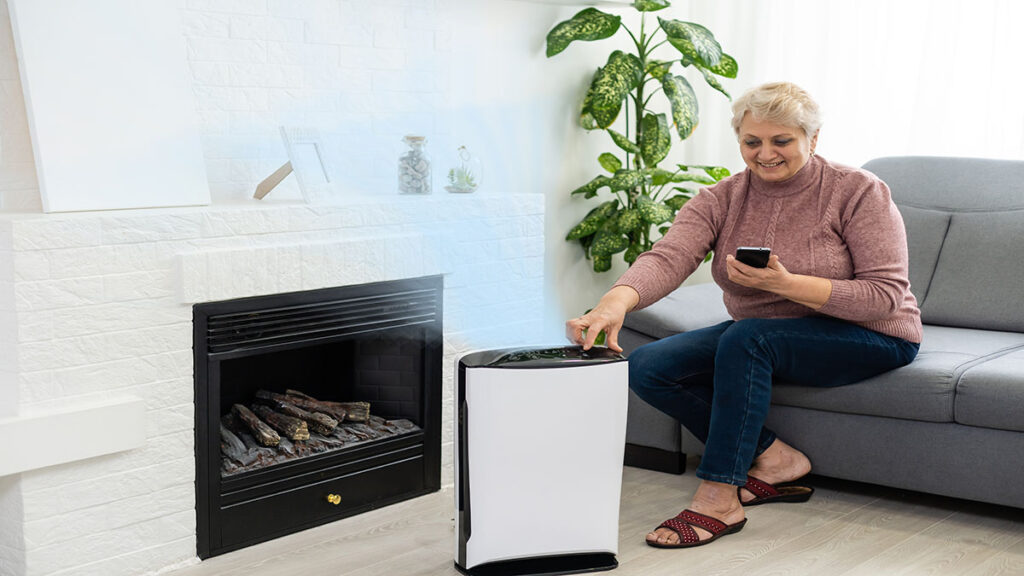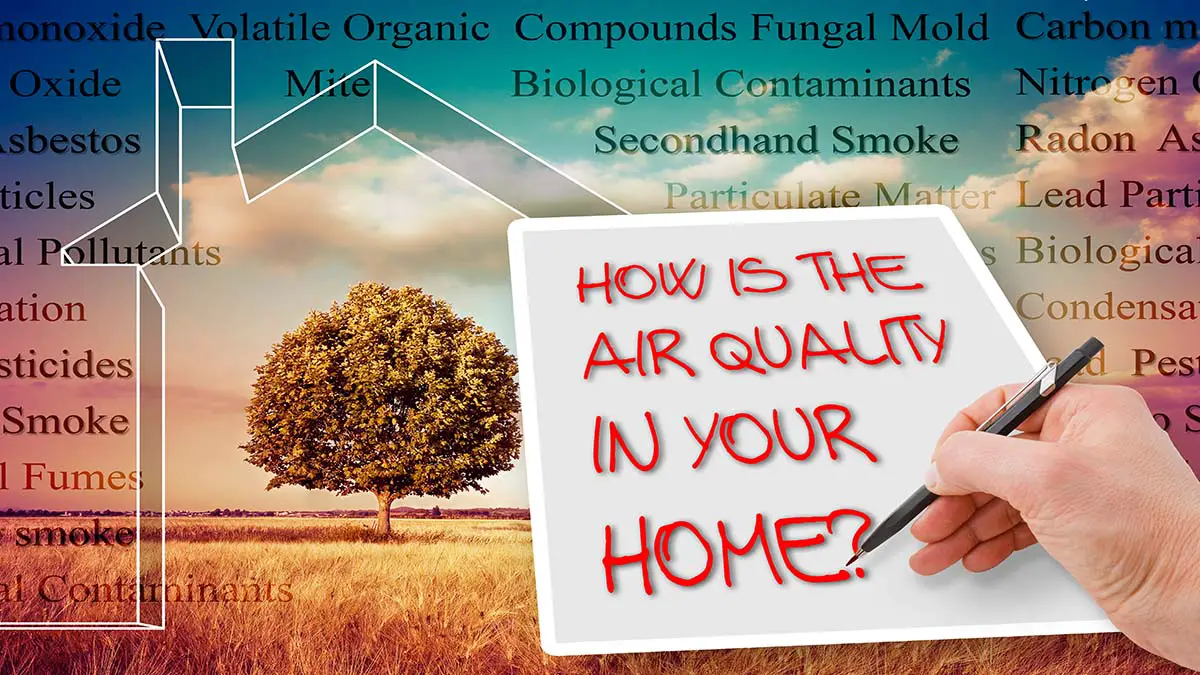Air quality tests are important for several reasons, including the detection of harmful pollutants, the improvement of overall well-being, and the protection of human health.
Indoor air quality testing can help identify and monitor levels of pollutants such as carbon monoxide, radon, volatile organic compounds, and other harmful materials, which can adversely affect human health.
By conducting air quality tests, potential pollutants can be identified, and appropriate measures can be taken to mitigate risks and protect the health of building occupants.
If you’re concerned about your air quality, you may consider getting an air quality test. An air quality test is a process that measures the concentration of pollutants in the air to determine if your indoor air is safe to breathe or if it has potential health risks.
You might want to get an air quality test for many reasons.
- If you’ve recently moved into a new home or apartment
- If you or someone in your household has been experiencing respiratory problems
- If recent environmental events, like wildfires, have occurred
- If you work in an industry that produces pollutants

Understanding Air Quality
Air quality refers to the condition of the air in your surroundings, including the presence of pollutants that can harm your health. Poor air quality can lead to various health problems like respiratory issues, heart disease, and cancer.
According to a recent study on time allocation among Americans, it was discovered that people typically spend 88% of their day indoors, 7% in transit, and a mere 5% of their time outdoors. 1
Air pollution is the primary cause of poor air quality. Pollutants such as carbon monoxide, nitrogen dioxide, sulfur dioxide, and particulate matter can enter the air from various sources, including vehicles, factories, and power plants.
An air quality monitor is used to measure air quality. An air quality monitor is a device that measures the concentration of pollutants in the air. The data collected by the air quality monitor is used to calculate the air quality index (AQI), a numerical value that indicates the pollution level in the air.
Outdoor air quality can vary depending on the location and time of day. For example, air quality in urban areas with heavy traffic may be worse than in rural areas. Air quality can also be affected by weather conditions such as wind, temperature, and humidity.
Air quality testing is essential to ensure your air is safe. Regular air quality testing can help detect harmful pollutants in your surroundings and help you take appropriate measures to protect your health.
Health Implications of Poor Air Quality
Breathing in poor-quality air can have profound health implications. The pollutants in the air can cause both short-term and long-term health problems. Short-term effects include headaches, coughing, fatigue, and irritation of the eyes, nose, and throat. Long-term effects can include cancer, shortness of breath, and wheezing.
Air pollution can also aggravate health conditions such as asthma, chronic bronchitis, and emphysema. People with these conditions are more susceptible to the harmful effects of air pollution. Children, the elderly, and those with weakened immune systems are also at a higher risk.
According to a study published in the Thorax Journal, poor air quality in classrooms can lead to asthma and rhinitis in primary schoolchildren. The study found that children exposed to poor air quality in classrooms had a higher risk of developing asthma and rhinitis. 2
Air pollution can also have an impact on mental health. Studies have found a link between air pollution and depression, anxiety, and cognitive decline.

Indoor Air Quality
Indoor air quality (IAQ) refers to the quality of air within buildings and structures as it relates to the health and comfort of occupants. Poor IAQ can cause health problems, particularly respiratory issues, reducing productivity, absenteeism, and increased energy costs.
The quality of indoor air can be affected by various factors, including mold, dust, and chemicals. Asbestos can also contribute to poor IAQ in older homes. In addition, poor ventilation can lead to carbon dioxide and other pollutants buildup.
Ensuring your home or office is well-ventilated is important to maintain good IAQ. This can be achieved through fans, open windows, and air conditioning systems. Keeping your home or office clean and free of dust and other pollutants.
If you are concerned about indoor air quality, you can use an indoor air quality monitor to test the air. These monitors can detect a variety of pollutants, including volatile organic compounds (VOCs), carbon dioxide, and particulate matter. If you suspect that your home or office has poor IAQ, it is important to have it tested by a professional.
Common Pollutants and their Sources
Regarding air quality, several common pollutants can be found in homes and buildings. These pollutants can come from various sources, including materials used in construction, cleaning products, and pets. Here are some of the most common pollutants and their sources:
- Radon: A naturally occurring gas that comes from the ground. It can seep into buildings through cracks in the foundation and cause lung cancer.
- Carbon Monoxide: A gas produced by the incomplete combustion of fuels such as gas, oil, and wood. It can be deadly in high concentrations.
- Volatile Organic Compounds (VOCs): Chemicals emitted by materials such as paint, cleaning products, and furniture. They can cause eye, nose, and throat irritation, headaches, and even cancer.
- Mold Spores: Microscopic fungi that can grow in damp areas of a building. They can cause respiratory problems and allergic reactions.
- Particulates: Tiny particles from various sources, including combustion pollutants, dust, and pollen. They can cause respiratory problems and aggravate existing conditions such as asthma.
- Tobacco Smoke: A mixture of gases and particulates that can cause lung cancer, heart disease, and other health problems.
- Carbon Dioxide: A gas that is produced by human respiration. High concentrations can cause headaches, dizziness, and fatigue.
- PM2.5: Fine particulate matter that is less than 2.5 micrometers in diameter. It can come from various sources, including combustion pollutants and dust. It can cause respiratory problems and aggravate existing conditions such as asthma.
- Secondhand Smoke: The smoke exhaled by smokers or that comes from the burning end of a cigarette. It can cause lung cancer, heart disease, and other health problems.
- Formaldehyde is a chemical used in many building materials, including pressed wood products and insulation. It can cause eye, nose, and throat irritation, as well as cancer.
Impact of Ventilation and Humidity
The most critical factors are indoor air quality, ventilation, and humidity. Proper ventilation can help remove pollutants and improve air quality, while humidity levels can affect the comfort and health of occupants.
Ventilation can be achieved through various methods, such as opening windows, fans, or mechanical ventilation systems.
According to a study on ventilation system effectiveness, mechanical ventilation systems can significantly improve indoor air quality by filtering and distributing fresh air throughout the space. Proper humidity levels can help prevent the growth of mold and bacteria, which can negatively impact air quality and occupant health. 3
Regarding humidity levels, it’s important to maintain a balance between too much and too little humidity. High humidity can lead to mold growth and increased indoor pollutants, while low humidity can cause discomfort and respiratory problems.
According to a field study, occupants generally prefer humidity levels between 30% and 60%. 4
In addition to ventilation and humidity, other factors, such as the use of cleaning products and the presence of outdoor pollutants, can also impact indoor air quality. By ensuring proper ventilation and humidity levels, you can significantly improve the air quality in your indoor space.

Air Quality Testing and Monitoring
Ensuring your air is clean and healthy is crucial to maintaining good health. Air quality testing and monitoring is the process of assessing air quality in a specific environment. Testing can be done indoors or outdoors, and it involves measuring the levels of pollutants present in the air.
How to Test Home Air Quality
There are several ways to test home air quality:
Indoor Air Quality (IAQ) Test Kits: These kits typically include air sampling equipment and instructions on collecting air samples. You send the samples to a laboratory for analysis, and they will provide a detailed report on the air quality in your home.
Carbon Monoxide (CO) Detectors: Install CO detectors in your home to monitor the presence of this odorless and potentially harmful gas. Place them near bedrooms and other areas where you spend significant time.
Radon Test: Radon is a radioactive gas that can seep into homes from the ground. Use a radon testing kit or hire a professional to assess radon levels in your home.
Mold Testing: Mold can hurt indoor air quality. You can purchase mold testing kits to identify the presence of mold spores in your home. Consider consulting with a professional mold inspector for a more comprehensive assessment.
Air Quality Monitors: These devices measure various pollutants, such as particulate matter (PM2.5 and PM10), volatile organic compounds (VOCs), and carbon dioxide (CO2). They provide real-time data on air quality and can help you identify potential issues.
Different types of air quality monitors and detectors are available on the market, including carbon monoxide detectors, indoor air quality monitors, and smoke detectors. These devices work by detecting and measuring the levels of specific pollutants in the air.
Carbon monoxide detectors are designed to detect the presence of carbon monoxide, a colorless, odorless gas that can be deadly if inhaled in large quantities. These will not detect other harmful air contaminants.
Indoor air quality monitors measure the levels of various air pollutants such as dust, mold, and volatile organic compounds (VOCs). Smoke detectors are used to detect the presence of smoke, which can indicate a fire but don’t measure indoor air quality.
We recommend all homes have indoor air quality monitors and one or more air purifiers. The Airthings 2930 Wave Plus is an indoor air quality monitor that accurately records key pollutants such as carbon dioxide, volatile organic compounds (VOCs), and airborne chemicals.
Air quality testing is essential for identifying potential health hazards in the air. It can help you determine whether your home or workplace air is safe. Testing can also help you identify the sources of pollutants in the air, allowing you to take appropriate measures to eliminate them.
Cost of Air Quality Testing
The cost of air quality testing can vary depending on:
- where you live
- the size of the home or business
- the number of air samples needed
- the specific pollutants being tested for
The average cost for a basic air quality test ranges from $200 to $500. However, more comprehensive tests that require specialized equipment or the analysis of multiple samples can cost upwards of $1,000.

Air Purification Solutions
Improving indoor air quality is crucial to your health and well-being, especially if you spend a lot of time indoors. One way to achieve better air quality is by using an air purifier. Air purifiers remove pollutants and contaminants, such as dust, pollen, and smoke.
Air purifiers use filters to capture and trap particles and pollutants in the air. The most common type of filter used in air purifiers is a HEPA filter. HEPA stands for High-Efficiency Particulate Air, and these filters can capture particles as small as 0.3 microns in size. This means they can capture most airborne particles, including dust, pollen, and pet dander.
Different types of air purifiers are available on the market, each with its own features and benefits. Some air purifiers use multiple filters to capture various pollutants, while others use ionizers to charge particles in the air and make them easier to capture.
When choosing an air purifier, it is important to consider the size of the room you want to purify and the type of pollutants you want to remove. For example, if you have allergies or asthma, you may want to choose an air purifier with a HEPA filter that can capture allergens and other irritants.
In addition to air purifiers, other solutions can help improve indoor air quality. For example, you can use HEPA air filters in your HVAC system to capture pollutants and contaminants before circulating throughout your home. You can also use natural air purifiers like plants to help remove toxins.
- Jones AP. Indoor air quality and health. Atmospheric environment. 1999 Dec 1;33(28):4535-64. https://www.sciencedirect.com/science/article/abs/pii/S1352231099002721
- Annesi-Maesano I, Hulin M, Lavaud F, Raherison C, Kopferschmitt C, de Blay F, Charpin DA, Denis C. Poor air quality in classrooms related to asthma and rhinitis in primary schoolchildren of the French 6 Cities Study. Thorax. 2012 Aug 1;67(8):682-8. https://thorax.bmj.com/content/67/8/682.short
- Rudd, Armin, & Bergey, Daniel. Ventilation System Effectiveness and Tested Indoor Air Quality Impacts. United States. https://www.osti.gov/biblio/1126286
- Fang, L. & Wargocki, Pawel & Witterseh, Thomas & Clausen, Geo & Fanger, P.O.. (1999). Field study on the impact of temperature, humidity and ventilation on perceived air quality. Proceedings of Indoor Air ’99. 2. 107-112. https://www.researchgate.net/publication/284043716_Field_study_on_the_impact_of_temperature_humidity_and_ventilation_on_perceived_air_quality








